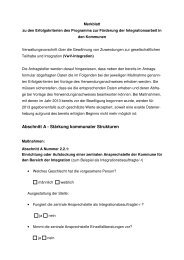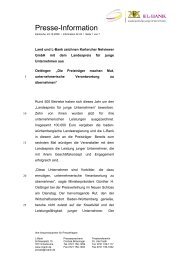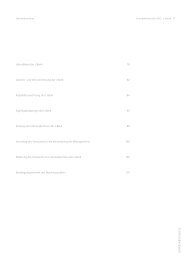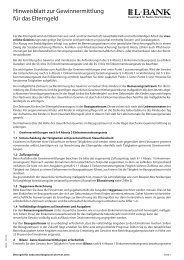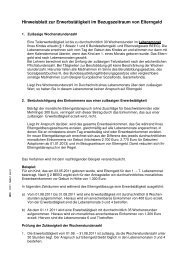Landeskreditbank Baden-Württemberg - L-Bank
Landeskreditbank Baden-Württemberg - L-Bank
Landeskreditbank Baden-Württemberg - L-Bank
Create successful ePaper yourself
Turn your PDF publications into a flip-book with our unique Google optimized e-Paper software.
Covering Market Risk Positions<br />
Market risk positions are foreign exchange positions, commodity positions and positions allocated to the<br />
Trading Book. The sum of the amounts of market risk positions and, under certain circumstances, separately<br />
computed option positions, may not exceed, at the close of each business day, the difference between the bank’s<br />
Own Funds and an amount equal to 8% of the risk-weighted assets and off-balance sheet items. Additionally, an<br />
overall ratio of the bank’s eligible capital (numerator) to the sum of (1) risk-weighted assets and off-balance<br />
sheet items plus (2) market risk positions and certain option positions, both multiplied by 12.5 (denominator),<br />
must be computed and must also be equal to at least 8%. The eligible capital is composed of the Liable Capital<br />
not used to cover other risks under Principle I and that portion of the Tier III Capital that is used to cover market<br />
risk positions and options. (The bank must also report to the BaFin for information purposes the ratio of Tier III<br />
Capital that remains unused but constitutes part of Own Funds to the above-mentioned denominator of the<br />
overall ratio). As a result, the amount of market risk positions must be covered by Liable Capital or Tier III<br />
Capital, whereas under the Solvency Ratio requirement, risk weighted assets and off-balance sheet items must be<br />
covered by Liable Capital. Therefore, (1) Tier III capital may only be used to cover market risk positions but not<br />
counterparty risk related to assets or off-balance sheet items, and (2) Liable Capital not used to cover<br />
counterparty risk related to assets and off-balance sheet items may be used to cover market risk positions.<br />
Principle I does not permit Own Funds that have already been used to cover a risk to cover other risks under<br />
Principle I.<br />
The risk-weighted values of such market risk positions and certain option positions must be computed in<br />
accordance with rules set forth in Principle I or, in the case of market risk positions, in accordance with the<br />
bank’s internal risk computation models which have been approved by the BaFin.<br />
During the period covered by this prospectus we have always met the risk-weighted capital adequacy rules<br />
of the German <strong>Bank</strong>ing Act.<br />
Liquidity Requirements<br />
The German <strong>Bank</strong>ing Act and the regulations issued by the BaFin and its predecessors also contain liquidity<br />
requirements. According to Principle II, banks must compute a liquidity factor at the end of every calendar<br />
month. The liquidity factor is the quotient of liquid assets to payment obligations during four time bands: (1) one<br />
day to one month; (2) more than one month to three months; (3) more than three months to six months; and (4)<br />
more than six months to twelve months. The liquidity factor for the one-month time band must not be less than 1.<br />
The excess of liquid assets over payment obligations in one of the other time bands may be counted as liquid<br />
assets for the succeeding time band. The ratios between the respective liquid assets over the payment obligations<br />
in the other three time bands are calculated for monitoring purposes only. The liquidity factor and the monitoring<br />
ratios must be submitted at the end of each calendar month to the Bundesbank, which passes the reports on to the<br />
BaFin.<br />
At December 31, 2004 and at the end of every calendar month during the period covered by this prospectus,<br />
we met the liquidity requirements of the German <strong>Bank</strong>ing Act.<br />
Limitation on Large Credits<br />
Own Funds and the distinction between Trading Book and Investment Book are also relevant for the<br />
limitations on large credits. The term “credit” is defined to include all items on the asset side of the balance sheet,<br />
derivative transactions and related guaranties and equivalent off-balance sheet positions. The term includes<br />
equity investments. Large credits are credits to a single borrower or a connected group of borrowers that equal or<br />
exceed 10% of the Liable Capital or Own Funds depending on whether the credit is allocated to the Investment<br />
Book or to the combined Investment Book and Trading Book. There is no separate Trading Book lending limit.<br />
The term “borrower” includes certain affiliates of the borrower. The limitations on large credits are applied on a<br />
risk-weighted basis in a manner similar to the application of the risk-weighted capital adequacy rules discussed<br />
above.<br />
40



